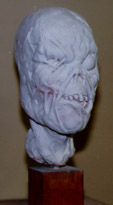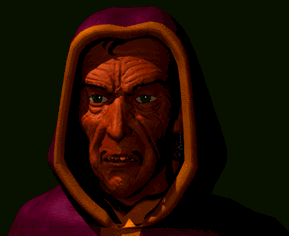
Some of the technology and people behind the Fallout talking heads
One of the technologically cool things in Fallout is the rendered heads used for major characters. This page will hopefully show you some of the work involved.
The design calls for a particular character, and gives a brief description. The concept artist takes the description and generates some sketch, or concept, art on paper.
These sketches are then given to the clay modeller, who creates a clay "bust" with the rough features. The bust is baked, or fired, to harden it.

"Ghoul" clay model
This bust is translated into a set of numbers describing the model in three dimensions via a digitizing arm by 3D artists, people who understand the relationship between 2D dimensions on screen and 3D renderings. They bring the basic 3D information into Lightwave, a software package to create rendered images, and begin the cleaning process.

"Morpheus" wireframe model
More 3D objects, such as hair, eyebrows, and ears are created and added. Texture maps, pictures that are applied to the surface of the 3D shape, are generated to give the fine detail, and the model is always being checked over for quality during all stages.

Basic 3D information
There is a period of fine-tuning. Lighting has to be created and adjusted to fit the character, and that particular characters location and role in the story. All the basic texture maps have to be finely detailed and then checked against the 3D shape. This can take a while, but it is the attention to detail that creates the illusion of life.

Initial texture maps, shoulders and clothes
Once the basic 3D model has been refined, detailed and approved, it still has to be animated. We use a method known as "keyframing". This means the artist manually adjusts the model to a particular animation periodically, and has the computer fill in the blanks.
Most of the animation required for our "talking heads" are phoneme frames, which represent the various positions a mouth and face use for speech. Other animations are fidgets, and transitions between emotional states.

A final render of "Morpheus"
Overall, the average head in Fallout will have between 220-280 frames of animation. Concurrent to the animation process, a voice actor is cast from some of the finest talent in Hollywood, and we go to the studio for recording.
In addition to the voice actor (the "talent"), there is a voice producer, an Interplay producer, an engineer, a sound technician, and a writer in the room. Each line can take between 2-10 takes to record (some actors can do it in one take, but you always want to record a "safety", in case there is a technical problem that you find later). A single character will have around 70-90 lines of dialogue to record. This usually takes 3-4 hours, but sometimes longer if the character is complex.
After the lines of dialogue are recorded, they are edited, mastered, and cut to disk. This is a task for 2-3 sound editors, and requires about a couple days of work for each character.
The lines are then transferred to the lipsyncher. This person creates an animation list by hand tuning a sequence of 9 unique frames, that represent the various phonemes, or speech sounds, for each emotional state into a completed line of dialogue.
This process takes about 8-10 weeks per talking head.

